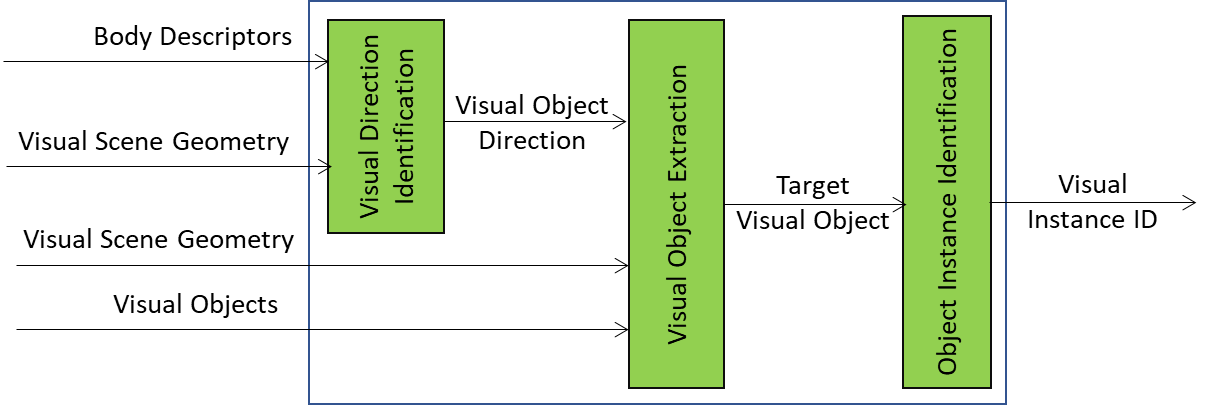The Visual Object Identification Composite AIM is specified in the following six sections.
1 Functions of Visual Object Identification
2 Reference Architecture of Visual Object Identification
3 Input/output data of Visual Object Identification
4 Functions of AI Modules of Visual Object Identification
.5 I/O Data of AI Modules of Visual Object Identification
6 AIM Specification and JSON Metadata of Visual Object Identification
1 Functions of Visual Object Identification
The purpose of the Visual Object Identification (OSD-VOI) AIM is to produce the Identifier of a Visual Object in a Visual Scene populated by a plurality of Objects that an Entity – the digital representation of a human or an Avatar – indicates by pointing at one of them with a finger.
2 Reference Architecture of Visual Object Identification
Figure 1 depicts the AIM implementing the Visual Object Identification AIM.

Figure 1 – Reference Model of the Visual Object Identification AIM
The workflow of the Visual Spatial Object Identification unfolds as follows:
- Direction Identification provides the (ϕ,θ) angles obtained by analysing the finger of the human.
- Visual Object Extraction uses the Visual Scene Geometry and the Direction to find the Object intersected by the line identified by (ϕ,θ) passing through the Entity’s straight finger. It is assumed that one and only one Object is found.
- Object Instance Identification provides the ID of the Object Instance.
3 Input/output data of Visual Object Identification
Table 1 gives the input/output data of Visual Object Identification.
Table 1 – I/O data of Visual Object Identification
| Input data | From | Comment |
| Body Descriptors | Upstream Visual Scene Description | There is a human pointing to an object |
| Visual Object | Upstream Visual Scene Description | There are many scene objects |
| Visual Scene Geometry | Upstream Visual Scene Description | Provides description of the scene |
| Output data | To | Comments |
| Visual Object Instance Identifier | Entity or another AIM | Human points to one object only |
4 Functions of AI Modules of Visual Object Identification
Table 2 gives functions of the AIMs.
Table 2 – AI Modules of Visual Object Identification
| AIM | Modules |
| Visual Direction Identification | Produces an Anchored Direction with the following features:
|
| Visual Object Extraction | Singles out the Visual Object indicated by the Entity. |
| Visual Instance Identification | Produces an Instance ID identifying an element of a set of Visual Objects belonging to a level in a taxonomy. |
5 I/O Data of AI Modules of Visual Object Identification
Table 3 gives the list of the AIMs with their functions.
Table 3 – AI Modules of Visual Object Identification
6 Specification of Visual Object Identification AIMs and JSON Metadata
Table 4 – AIM and JSON Metadata
| OSD-VOI | Visual Object Identification | X | ||
| OSD-VDI | Visual Direction Identification | X | ||
| OSD-VOE | Visual Object Extraction | X | ||
| OSD-VII | Visual Instance Identification | X | ||

